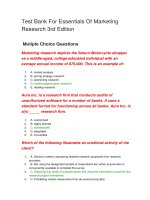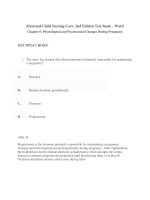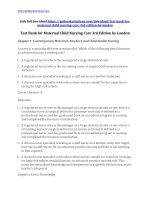Test bank for maternal child nursing care 3rd edition by wong
Bạn đang xem bản rút gọn của tài liệu. Xem và tải ngay bản đầy đủ của tài liệu tại đây (57.1 KB, 9 trang )
Full file at />
Wong, et al.: Maternal Child Nursing Care, 3rd Edition
Test Bank
Chapter 1: Contemporary Maternity Nursing
MULTIPLE CHOICE
1. Many alternative and complementary therapies share which of the following concepts?
1. The use of herbs is a cornerstone of good health.
2. Patients are capable of decision making and should be a part of the health care
team.
3. Touch should be used to relieve pain and reduce anxiety.
4. Patients should place the responsibility for their health and healing in the hands of
alternative healers.
ANS: 2
1. Incorrect: Proper nutrition, adequate rest, relaxation, exercise, and emotional health are
cornerstones of good health, not herbs.
2. Correct: The emphasis of alternative and complementary therapies is that the patient is
viewed as a whole being, capable of decision making, and an integral part of the health care
team.
3. Incorrect: The use of touch has many forms and is used for a multitude of purposes including
increased circulation, decreasing edema, promoting lymphatic drainage, relieving muscle
tension, and improving the functioning of certain body systems.
4. Incorrect: The road to healing is an individual journey; patients are encouraged to take
responsibility for their health and healing.
REF: p. 5
OBJ: Cognitive Level: Comprehension
2. Managed care is gaining popularity. This rise in popularity is most often guided by which of
the following considerations?
1. Concern for the quality of care
2. Means of controlling costs of care
3. Greater access to physicians
4. Allowance for early discharge
ANS: 2
1. Incorrect: Although quality control is important, it does not have any bearing on the rise of
popularity of managed care.
2. Correct: Health care is one of the fastest growing sectors of the U.S. economy. Managed care
was developed as a direct result of escalating health care costs.
3. Incorrect: Managed care tends to have a gatekeeper effect, which actually may limit the access
to physicians, especially specialists.
buy this full document at
Full file at />4. Incorrect: Although early discharges were originally part of the managed care plan to reduce
hospital expenditures, they have created a need for additional care in the home.
REF: p. 12
OBJ: Cognitive Level: Knowledge
3. The role of the professional nurse has evolved to emphasize:
1. providing care to patients directly at the bedside.
2. planning patient care to cover longer hospital stays.
3. leading the activities of a team of interdisciplinary health care providers.
4. managing care to cure health problems once they have occurred.
ANS: 3
1. Incorrect: This is one task of the role of a nurse but is not what encompasses the notion of the
evolved professional nurse.
2. Incorrect: One goal of managed care is decreased, not increased, length of stays.
3. Correct: Professional nurses are part of the team of health care providers who collaboratively
care for patients in the managed care model.
4. Incorrect: Nurses do not cure health problems; they care for patients with health care ailments.
REF: p. 4
OBJ: Cognitive Level: Knowledge
4. To assess for the risk of having a low-birth-weight (LBW) infant, which of the following
factors is the most important for the nurse to consider?
1. African-American race
2. Cigarette smoking
3. Poor nutritional status
4. Limited maternal education
ANS: 1
1. Correct: For African-American births, the incidence of LBW infants is twice that of
Caucasian births. Race is a nonmodifiable risk factor.
2. Incorrect: Cigarette smoking is an important factor in potential infant mortality rates but is not
the most important. Additionally, smoking is a modifiable risk factor.
3. Incorrect: Poor nutrition is an important factor in potential infant mortality rates but is not the
most important. Additionally, nutritional status is a modifiable risk factor.
4. Incorrect: Maternal education is an important factor in potential infant mortality rates but is
not the most important. Additionally, maternal education is a modifiable risk factor.
REF: p. 9
OBJ: Cognitive Level: Comprehension
5. A 23-year-old African-American woman is pregnant with her first child. Based on the
statistics related to infant mortality, which of the following plans is most important for the
nurse to implement?
buy this full document at
Full file at />1.
2.
3.
4.
Perform a nutrition assessment.
Refer the woman to a social worker.
Advise the woman to see an obstetrician and not a midwife.
Explain to the woman the importance of keeping her prenatal care appointments.
ANS: 4
1. Incorrect: Nutritional status is an important modifiable risk factor, but is not the most
important action for a nurse to take in this situation.
2. Incorrect: The patient may need assistance from a social worker at some time during her
pregnancy but it is not the most important aspect for the nurse to address at this time.
3. Incorrect: If the woman were to have identifiable high risk issues, her health care may be
provided by a physician. However, it cannot be assumed that all African-American women have
high risk issues. Additionally, it is not the most important aspect for the nurse to focus on at this
time, nor is it appropriate for a nurse to advise or manage the type of care a patient is to receive.
4. Correct: Consistent prenatal care is the best method of preventing or controlling risk factors
associated with infant mortality.
REF: p. 9
OBJ: Cognitive Level: Comprehension
6. The nurse will know that teaching to increase self-care is effective when the patient makes
which of the following comments?
1. “I’ll do whatever you say; you’re the nurse.”
2. “I don’t think I can quit smoking.”
3. “I exercise for 30 minutes 3 days a week.”
4. “What do you think I should do?”
ANS: 3
1. Incorrect: Doing is different from comprehension. The goal of teaching about self-care is for
the patient to understand the factors associated with her care. Generally, an understanding of selfcare practices increases the chances of patients practicing healthy behaviors.
2. Incorrect: Smoking is only one behavior associated with self-care in pregnancy. Additionally,
the goal is for the patient to seek self-care health behaviors, not discount them.
3. Correct: This statement indicates the patient’s willing participation and understanding of
healthy self-care behaviors.
4. Incorrect: The patient’s question indicates that she does not understand what measures she can
take to increase her level of self-care.
REF: p. 10
OBJ: Cognitive Level: Application
7. When managing health care for pregnant women at a prenatal clinic, the nurse should
recognize that the most significant barrier to access to care is the pregnant woman’s:
1. age.
2. minority status.
3. educational level.
buy this full document at
Full file at />4. inability to pay.
ANS: 4
1. Incorrect: While adolescent pregnant patients statistically receive less prenatal care, this factor
is not the most significant barrier.
2. Incorrect: Significant disparities in morbidity and mortality rates exist for minority women.
However, this is not the most significant barrier to access of care.
3. Incorrect: Disparities in educational level are associated with morbidity and mortality rates;
educational level is not the most significant barrier to access of care.
4. Correct: The most significant barrier to health care access is the inability to pay for services.
This is compounded by the fact that many physicians refuse to care for women who cannot pay.
REF: p. 12
OBJ: Cognitive Level: Knowledge
8. What is the primary role of practicing nurses in the research process?
1. Designing research studies
2. Collecting data for other researchers
3. Identifying researchable problems
4. Seeking funding to support research studies
ANS: 3
1. Incorrect: Designing research studies is only one factor of the research process.
2. Incorrect: Data collection is only factor of research.
3. Correct: By identifying problems, research can be properly conducted. Research of health
care issues leads to evidence-based practice guidelines.
4. Incorrect: Financial support is necessary to conduct research but it is not the primary role of
the nurse in the research process.
REF: p. 19
OBJ: Cognitive Level: Comprehension
9. When the nurse is unsure about how to perform a patient care procedure, the nurse’s best
action would be to:
1. ask another nurse.
2. discuss the procedure with the patient’s physician.
3. look up the procedure in a nursing textbook.
4. consult the agency procedure manual and follow the guidelines for the procedure.
ANS: 4
1. Incorrect: Each nurse is responsible for his/her own practice. Relying on another nurse may
not always be safe practice. Each nurse is obligated to follow the standards of care for safe
patient care delivery.
2. Incorrect: Physicians are responsible for their own patient care activity. Nurses may follow
safe orders from physicians but are also responsible for the activities that they as nurses are to
carry out.
buy this full document at
Full file at />3. Incorrect: Information provided in a nursing textbook is basic information for general
knowledge. Furthermore, the information in a textbook may not reflect the current standard of
care or individual state/hospital policies.
4. Correct: It is always best to follow the agency’s policies and procedures manual when
seeking information on correct patient procedures. These policies should reflect the current
standards of care and state guidelines.
REF: p. 18
OBJ: Cognitive Level: Comprehension
10. Which of the following measures should be the focus of the health care system in order to
further reduce the rate of infant mortality?
1. Implementing programs to ensure women’s early participation in ongoing prenatal
care
2. Increasing the length of stay in a hospital after vaginal birth from 2 to 3 days
3. Expanding the number of neonatal intensive care units
4. Mandating that all pregnant women receive care from an obstetrician
ANS: 1
1. Correct: Early prenatal care allows for early diagnosis and appropriate interventions to reduce
the rate of infant mortality.
2. Incorrect: An increased length of stay has shown improved self-care and parental education.
However, it does not prevent the incidence of leading causes of infant mortality rates such as
LBW.
3. Incorrect: Early prevention and diagnosis reduce the rate of infant mortality. NICUs offer care
to high risk infants after they are born. Expanding the number of NICUs would offer better
access for high risk care, but is not the factor that should be the primary focus for further
reduction of infant mortality rates.
4. Incorrect: A mandate that all pregnant women receive obstetric care would be nearly
impossible to enforce. Furthermore, CNMs have demonstrated reliable, safe care for pregnant
women.
REF: p. 9
OBJ: Cognitive Level: Comprehension
11. Alternative and complementary therapies:
1. replace conventional Western modalities of treatment.
2. are used by only a small number of American adults.
3. recognize the value of patients’ input into their health care.
4. focus primarily on the disease an individual is experiencing.
ANS: 3
1. Incorrect: Alternative and complementary therapies are part of an integrative approach to
health care.
2. Incorrect: An increasing number of American adults are seeking alternative and
complementary health care options.
buy this full document at
Full file at />3. Correct: Many popular alternative healing modalities offer human-centered care based on
philosophies that recognize the value of the patient’s input and honor the individual’s beliefs,
values, and desires.
4. Incorrect: Alternative healing modalities offer a holistic approach to health, focusing on the
whole person, not just the disease.
REF: p. 5
OBJ: Cognitive Level: Comprehension
12. When caring for pregnant women, the nurse should be aware that one of the most frequently
reported maternal medical risk factors is:
1. diabetes mellitus.
2. mitral valve prolapse.
3. chronic hypertension.
4. anemia.
ANS: 1
1. Correct: The two most frequently reported maternal medical risk factors are hypertension
associated with pregnancy and diabetes.
2. Incorrect: There are no studies that indicate that MVP is among the most frequently reported
maternal risk factors.
3. Incorrect: Hypertension associated with pregnancy is one of the most frequently reported
maternal medical risk factors, not chronic hypertension.
4. Incorrect: Although anemia is a concern in pregnancy, it is not one of the most frequently
reported maternal medical risk factors in pregnancy.
REF: p. 12
OBJ: Cognitive Level: Knowledge
13. The nurses working at a newly established birthing center have begun to compare their
performances in providing maternal–newborn care with the performances of nurses working
in similar settings. This comparison process, designed to improve the quality of patient care,
is called:
1. best practices networking.
2. clinical benchmarking.
3. outcomes-oriented care.
4. evidence-based practice.
ANS: 2
1. Incorrect: Best practice refers to a program or service that has been recognized for excellence.
2. Correct: Clinical benchmarking is a process used to compare one’s own performance against
the performance of the best in an area of service.
3. Incorrect: Outcomes-oriented care measures effectiveness of interventions and quality of care.
4. Incorrect: Evidence-based practice refers to providing care based on evidence gained through
research and clinical trials.
buy this full document at
Full file at />REF: p. 17
OBJ: Cognitive Level: Comprehension
14. Contemporary maternity nursing is exemplified by:
1. the use of midwives for all vaginal deliveries.
2. family-centered care.
3. freestanding birth clinics.
4. physician driven care.
ANS: 2
1. Incorrect: Midwives and physicians are utilized for vaginal deliveries.
2. Correct: Contemporary maternity nursing focuses on the family’s needs and desires.
3. Incorrect: Free standing clinics are an example of alternative birth options.
4. Incorrect: Contemporary maternity nursing is driven by the relationship of nurses with
patients.
REF: p. 7
OBJ: Cognitive Level: Comprehension
15. Sally, a 38-year-old Hispanic woman, delivered a 9-pound, 6-ounce baby girl vaginally after
being in labor for 43 hours. The baby died 3 days later from sepsis. On what grounds would
Sally potentially have a legitimate legal case for negligence?
1. She is Hispanic.
2. She delivered a girl.
3. The Standards of Care were not met.
4. She refused fetal monitoring.
ANS: 3
1. Incorrect: The patient’s race is not a factor for a case of negligence.
2. Incorrect: The infant’s sex is not a factor for a case of negligence.
3. Correct: Not meeting the standards of care is a legitimate factor for a case of negligence.
4. Incorrect: Although fetal monitoring is the standard of care, the patient has the right to refuse
treatment. This refusal is not a case for negligence but the patient should give proper consent and
sign an AMA form for refusal of any treatment that is within the standard of care.
REF: p. 18
OBJ: Cognitive Level: Analysis
16. All of the following have contributed to the increase in maternity-related health care costs
except:
1. early postpartum discharges.
2. maternal medical risk factors such as diabetes.
3. the use of high-tech equipment.
4. the cost of care for LBW infants.
ANS: 1
buy this full document at
Full file at />1. Correct: Early postpartum discharges have reduced costs.
2. Incorrect: High risk factors increase health costs.
3. Incorrect: High-tech equipment increases health costs.
4. Incorrect: LBW or high-risk infants increase health costs.
REF: p. 12
OBJ: Cognitive Level: Evaluation
17. One method that maternity nurses can use to dispel the health disparities among women is
through:
1. increased education provided for mothers.
2. late prenatal care.
3. increasing the number of cesarean sections.
4. making all women take more vitamins.
ANS: 1
1. Correct: Education for mothers will enable them to recognize problems to report to their
providers and teach them how to take better care of themselves.
2. Incorrect: Late prenatal care is one factor that contributes to health disparities.
3. Incorrect: Cesarean sections occur for various reasons, but may be the result of health
concerns related to the mother.
4. Incorrect: Taking vitamins may improve overall health but does not necessarily ensure health
or dispel health disparities.
REF: p. 10
OBJ: Cognitive Level: Application
OTHER
1. What methods would help alleviate the problems associated with access to health care?
(Choose all that apply.)
1. Provide transportation to prenatal visits
2. Provide child care so that a pregnant mother may attend prenatal visits.
3. Mandate that physicians make “house calls”
4. Provide low-cost or no-cost health care insurance.
5. Provide job training.
ANS:
1, 2 and 4
1, 2 and 4. Correct: No transportation to visits, lack of child care, and no affordable health
insurance are prohibitive factors associated with lack of prenatal care.
3. Incorrect: House calls are not a cost-effective approach to health care.
5. Incorrect: Although job training may result in employment and income, the likelihood of
significant changes during the timeframe of the pregnancy is remote.
buy this full document at
Full file at />REF: p. 12
OBJ: Cognitive Level: Evaluation
buy this full document at









